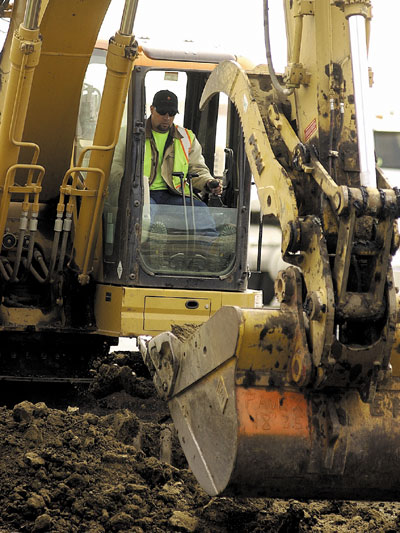As if local building and engineering contractors aren’t already
having a hard time finding work in San Benito County, the current
real estate slump definitely makes it harder to find work just
about anywhere.
As if local building and engineering contractors aren’t already having a hard time finding work in San Benito County, the current real estate slump definitely makes it harder to find work just about anywhere.
“In a nut shell, it’s been tough,” said Don Neilson, general contractor of Neilson Construction in Hollister. “Ultimately, it is just a lack of work. It is slow everywhere and I haven’t seen it this slow in 20 years,” he said
Hollister was one of the fastest growing cities in the 1990s, when city councils were approving development at a rapid pace.
Housing projects were popping up all over the west and south ends of town. Real estate was hot and the population had nearly doubled in a decade, from 20,000 residents to 37,000 residents, according to the 2000 U.S. Census.
Big money was made in real estate deals and the city racked in building fees that big developers paid up-front – but with little thought given to how that growth affected the city’s infrastructure.
With construction nonexistent in Hollister since the 2002 city building moratorium imposed by the Regional Water Quality Control Board, local contractors have been forced to look to areas outside of the county for stable work.
The regional water board imposed the moratorium almost six years ago after a backup in the city’s sewage system caused a breech in one of its supporting levees and spilled more than 15 million gallons of household sewage into the San Benito River bed.
The current city ban on building and the market crisis haven’t hurt just home and commercial contractors, but they also put civil engineering contractors in a tight spot.
According to Pat Christensen, general engineering contractor for Christensen Construction, the city’s limited infrastructure and building opportunities have forced him and other contractors to turn to a Web site called thebluebook.com for developments that offer contracts in the middle of their planning process along with jobs that are seeking contract bids.
“A lot of us don’t work out here anymore,” Christensen said. “Now they are going wherever they need to. There really isn’t any future in this town. Hollister is a nice bedroom town, but residential building is dead everywhere and it’s hurting everybody.”
The construction veteran who has been in the Hollister area since 1983 said that his firm had just completed Big League Dreams Sports Complex in Manteca and paved a new shopping center in King City. While his firm is out of town, the crew stays in hotels during the week and comes home on weekends.
Tony Moge, the sole proprietor of Fault Line Electric, said that he, as well as his network of contracting partners, have resorted to heading to areas outside of the county as well.
Moge, who specializes in home electric work, has relocated to Salinas, Monterey and Carmel and has seen a lot of his colleagues travel up to San Jose for work.
“It’s slow in San Benito County, but in general, it’s not totally a San Benito thing,” Moge said. “At the end of 2007 and in January 2008, it was really tough – nobody wanted to build.”
Moge also said that the temporarily-defunct San Benito Contractor’s Association is a reliable resource for work and business strategies but currently does not have a president.
With the city in the midst of building a more than $100 million sewage facility and the moratorium being lifted in the coming months, Mayor Doug Emerson is eager to get back to building with a managed-growth philosophy.
The city is already slated to build 1,124 homes by 2012 as part of its General and Downtown Specific Plan for mixed-use development and it gave out 1,170 grant allocations to builders prior to the ban.
“We are trying to stick to our general development plan that calls for 2.6 percent growth from 2005 to 2023, and we are doing everything we can to uphold that plan,” Emerson said. “We have a local growth initiative that still allows us to give out building allocations to developers.”
Measure U, which was approved by voters in the past, allows the city to hand out 244 building allocations a year to developers, but the developers can’t build until the moratorium is lifted.
Emerson said that the city will come out of the moratorium issuing 350 building permits annually – that’s what construction can actually happen. He noted how Cupertino developer Marty Miller will oversee the building of 170 housing units.
According to Neilson, who has found work in areas in Saratoga, San Jose and Morgan Hill, people won’t be in a rush to spend money on home expansion or re-modeling, in which his business specializes.
“The city will release 600 building permits out to contactors to work here in Hollister,” Neilson said. “But this is one of those hang-on years, where people are going to want to hang on to their money and nobody wants to spend. But next year should be better than this one.”










